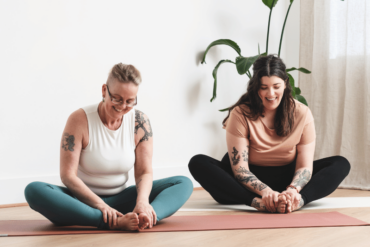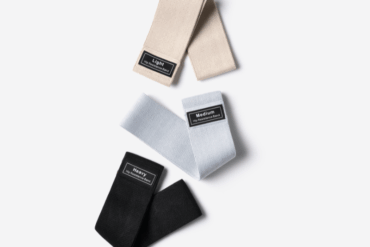We are big fans of allowing space for our students to find rhythm and ease in their practice. We might think about rhythm as our own individual pace or tone in any given moment – are you feeling tired, slow, speedy, wriggly, or any other way? Finding our own rhythm allows us a sense of agency and empowerment within our practice. Ease is the natural counterpart to rhythm. Where can we allow more comfort, more rest, more space into our practice? Often we need a bit of rhythm to help us explore ease.
As you move through the suggested postures below, we’d encourage you to take a few moments to wriggle and move in any way that feels good for you, before coming to a few moments of stillness and rest in the posture. Take as much time as feels good before moving on.
Sitting to Find Rhythm
In a comfortable seated position, we can find rhythm and ease by gently exploring our centre. Take a few rocks side-to-side, then front-to-back, finding where you feel centred in the middle of your seat. You might even take a few circles, sways, or any other movements that feel good for you. If it feels comfortable, you can bring your attention to your breath for a few moments.
Suggested alignment:
Shoulders stacked over hips
Elbows softly fall underneath shoulders
Legs can be crossed at shins or ankles
Encourage shoulders to relax down and away from ears.
Tuck chin slightly to lengthen back of the neck
Hands can find any comfortable position
Enhance: Raise the height of your hips by sitting on a block, blanket or cushion. This will help your knees fall away and relieve tension in your lower back, making it easier to maintain a straight spine. Sitting against a wall can help relieve tension & strain in the back whilst getting used to sitting cross-legged.
Mermaid Pose
This is a personal favorite of both Theo and Harriet. We love this pose for all of the rocking, swaying and options for intuitive movement it offers.
Suggested Alignment:
Sole of front foot rests into thigh of back leg
Back leg has foot drawn towards thigh in “mermaid” or “deer” position
Pelvis may not be entirely level on the mat – support with a folded blanket or cushion
Swing one leg out to the side and back, tucking the foot as close to that hip as is comfortable. Bend the front leg and bring the sole of the foot towards the top of the back thigh. From this position, you can take side bends, twists, rocking actions, or bring one hand behind you, lifting the higher hip even more and reaching up and arching back into a “baby wild thing” position.
Enhance: It is highly likely that the sitting bones will not be level on the mat in this position – sitting on a small cushion or folded blanket can help them feel more even and grounded if that is comforting.
Wide-Legged Seated Position
You might be noticing a theme here – we love a posture from which you can explore all sorts of movements. In a wide-legged position you can make small or big circles, twist, side bend or fold forward. You can take a few breaths in each position, or wriggle and move continuously from one version to another.
Suggested alignment:
Raise seat by sitting on thin block or blanket
Take legs apart just as far as feels comfortable, actively flexing feet
Lengthen through spine, lifting heart forward
Enhance: Use hands on floor or blocks/bolster to support and ground from the torso. Sit on a bolster or as many blankets as you like.
Camel Pose
This is not necessarily a pose we associate with rhythm & ease, but Camel can be a great way to gently bring some strength and focus to your practice. Rather than staying static in the pose, you can try moving in and out of the back bend a few times, lifting and lowering the hips from kneeling. You might even incorporate lifting/lowering the arms.
Suggested alignment:
Hips over knees, thighs pressing forward
Lifting through pubic bone
Chest lifting to sky
Come to a kneeling position, beginning with your toes tucked if it is comfortable for you. Stack your hips over your knees, and bring your hands into your lower back, or bring your palms to meet at your heart. Squeeze your elbows and shoulders together and down.
As you inhale, begin to press your hips forward, curling the top of your spine back. Think about lifting from the top of your chest amd avoid hyper-extending into your lower back. On an inhalation, stack your shoulders back over your hips, then release back to a kneeling position.
Enhance: If your knees are tender, pad them with a blanket or by rolling up a bit of your mat.
Baddha Konasana / Butterfly Pose
Another great pose for rocking, rolling and wriggling. If you want to go for a more restorative option, take your feet further away and a bolster under your knees for a supported forward fold.
Suggested Alignment:
Soles of feet together, heels as close to groin as is comfortable
Knees fall apart comfortable
Hands around outside edges of feet/resting on shins or ankles
Lengthening through spine
Shoulders draw back and down
Slight anterior pelvic tilt
Bring the soles of your feet together, shuffling your bottom as close to your feet as is comfortable. Actively press your knees down towards the floor using your thigh muscles. As you inhale, lengthen your spine and expand through your collarbones. As you exhale, hinge forward from your hips, thinking about taking your chest forward, but keeping your spine straight.
Enhance: Sitting on a block can greatly enhance the space available through the hips, whilst also protecting the lower back. You might also like to take support under the knees if there is any discomfort in the front of the pelvis.
The post 5 Poses to find Rhythm and Ease appeared first on Blog – Yogamatters.



